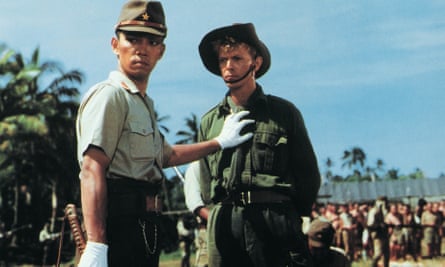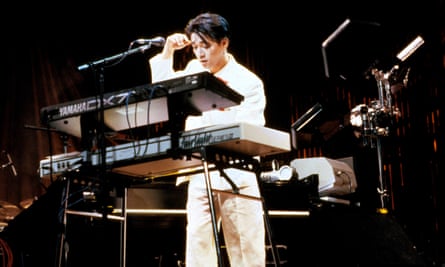Ryuichi Sakamoto was not a man cut out to be a pop star. As a teenager, he liked the Beatles and the Rolling Stones, but his abiding passion was New York’s underground avant garde art scene – Joseph Beuys, Fluxus, Andy Warhol – and its accompanying experimental music: he was fond of pointing out to interviewers that he was born the year that John Cage composed 4’33. At university, he studied the work of modern composers Boulez, Stockhausen and Ligeti; he had a particular interest in the challenging electronic compositions of Iannis Xenakis. The first album to bear Sakamoto’s name, 1975’s Disappointment/Hateruma, was a collaboration with percussionist Toshiyuki Tsuchitori that consisted entirely of free improv. If he was going to have a role in the Japanese pop world at all, it was in the background, using his keyboard skills and interest in the fast-developing world of synthesisers to find employment as a session musician.
But a pop star was exactly what Sakamoto became, at least for a time. A 1978 session for singer Haruomi Hosono led to the suggestion that they should form a band with drummer Yukihiro Takahashi. Yellow Magic Orchestra went on to become both the biggest band in Japan – inspiring a degree of paparazzi attention and screaming fervour among fans that Sakamoto seems to have loathed every minute of – and the first Japanese artists to find more than novelty or cult status in the west.
Yellow Magic Orchestra were successful, but they were groundbreaking too. The convenient shorthand was that they were the Japanese Kraftwerk, although in truth, YMO didn’t really sound like Kraftwerk at all. Alongside the synthesizers, they used guitars, bass and acoustic drums. They were more straightforwardly aligned to disco: their debut album even featured an electronic version of the deathless “ooah ooah” whoop from the Michael Zager Band’s Let’s All Chant. You could detect the influence of jazz fusion and, later, the UK’s ongoing ska revival. Like Throbbing Gristle, they appeared fascinated by the kitschy 1950s exotica of Martin Denny and Arthur Lyman, which had featured traditional Japanese instruments and quasi-“oriental” melodies; Yellow Magic Orchestra’s biggest international hit was a version of Denny’s 1959 track Firecracker.
Equally, you could see why the Kraftwerk comparison stuck. Both bands shared an obsession with technology – Yellow Magic Orchestra were pioneering in their use of sequencers and samplers and they introduced the world to the sound of the Roland TR-808 drum machine – and a belief that being cutting-edge experimentalists didn’t preclude them from writing fantastic pop songs. The Sakamoto-penned Behind the Mask, from 1979’s Solid State Survivor, was covered by Michael Jackson, ostensibly for inclusion on Thriller, although it was dropped from the final tracklisting; it was eventually turned into a UK hit by, of all people, Eric Clapton.
Both YMO and Kraftwerk were interested in the detournement of Anglo-American pop: just as Kraftwerk borrowed from the Beach Boys on Autobahn, so YMO covered the Beatles’ Day Tripper and Archie Bell and the Drells’ Tighten Up, the latter in cartoonish Japanese accents. They also shared a dry sense of humour, which in Yellow Magic Orchestra’s case usually fixated on western prejudices and fears about east Asians. On the cover of Solid State Survivor, they dressed in red Mao suits, enjoying a drink with an effigy of the late dictator. While the US fretted about an influx of Japanese cars and technology damaging their economy, 1980’s X∞Multiplies featured a series of sketches, one featuring a sinister Japanese businessman signing a contract, another featuring an American who realises his Japanese host can’t understand English and lets rip with a torrent of racist abuse: “The Japanese are pigs, yellow monkeys, they have small cocks and short legs.” As a moral panic erupted over the deleterious and addictive effect of the Taito Corporation’s Space Invaders games, Yellow Magic Orchestra’s records literally sounded like arcade games: their eponymous debut album was packed with interludes featuring their bleeping noises and tinny Game Over death marches.
And, like Kraftwerk, Yellow Magic Orchestra proved vastly influential – or rather, it took the rest of the world a little while to catch up: there was something telling about the fact that Solid State Survivor wasn’t released in the UK until 1982, at the height of the synth-pop wave that YMO had presaged. By then, their music had found its way into the collections of DJs and producers in New York’s burgeoning hip-hop scene – they were apparently astonished when the audience on Soul Train began breakdancing when they performed Computer Games – although it was a track from one of the solo albums Sakamoto had begun releasing concurrent with his career in YMO that had the biggest long-term impact. Riot in Lagos, from 1980’s B-2 Unit, had been recorded in London with reggae producer Dennis Bovell, and was apparently inspired by the Afrobeat of Fela Kuti. It remains an astonishingly timeless and effervescent piece of electronica: if you didn’t know it and were told it was released last month, rather than 42 years ago, you’d believe it. Abstract but funky, it cast a considerable shadow over dance music: it was big club hit on release, helped shape the sound of electro and turned the head of hip-hop producers including Kurtis Mantronik. Drum n’ bass producers Foul Play sampled it, and you can hear its influence in the music of 90s electronic luminaries Aphex Twin and Autechre.
Yellow Magic Orchestra split in 1983. If Sakamoto had left it at that and returned to modern classical music, he would already have earned himself a place among the era’s greatest pop innovators. But with the release of Nagisa Ōshima’s film Merry Christmas Mr Lawrence, in which he also starred, he began a career as a soundtrack composer that clearly suited his temperament far better than the Beatlemania-like scenes Yellow Magic Orchestra had provoked at home. It would lead him to work with Bernardo Bertolucci, Pedro Almodóvar, Brian De Palma and Oliver Stone, among others, and be showered with awards, including an Oscar and a Golden Globe.

But the vocal version of Merry Christmas Mr Lawrence’s haunting main theme, retitled Forbidden Colours, also cemented a partnership with former Japan vocalist David Sylvian that had begun with the 1982 single Bamboo Houses/Bamboo Music. Along with Can’s Holger Czukay and experimental trumpeter Jon Hassell, he became part of Sylvian’s repertory company for a series of extraordinary albums that attempted to reimagine 80s pop in a more expansive, exploratory and pensive way.
They seemed to reflect Sakamoto’s own position within pop after Yellow Magic Orchestra. Sakamoto’s solo albums largely contained music that existed at one remove from whatever else was happening, in a space where he could follow his own path. On 1989’s Beauty and 1991’s Heartbeat, it sometimes seemed as if he was constructing his own brand of the exotica that had entranced YMO, blending eastern, western and African influences together, assembling eclectic and improbable guest lists that, on Beauty alone, included Youssou N’Dour, Robbie Robertson, Robert Wyatt, Brian Wilson and Prince protege Jill Jones.
It wasn’t as if Ryuichi Sakamoto needed to be at the centre of pop culture in person: thanks to sampling, the centre of pop culture was never that far from his music. In recent years, it’s been borrowed by the Weeknd, Justice, Burial, the Beastie Boys, Jennifer Lopez, Brandy and Freddie Gibbs.
In the late 70s, the other members of Yellow Magic Orchestra had called him the Professor, a jokey nickname that contrasted Sakamoto’s intellectual bearing with his unwanted role as the group’s main heart-throb. It was a title Sakamoto seemed to grow into more and more in his later years: recording minimalist albums with German artist Alva Noto, providing ambient scores for art installations, releasing live orchestral and solo piano recordings of his compositions. There are clips of Yellow Magic Orchestra in the 2017 documentary Coda, which showed Sakamoto returning to work following a diagnosis of throat cancer, but it’s still hard to square the young pop star who stares imperiously down from his apartment wall in a portrait by Andy Warhol with the man in his late 60s, learnedly discussing classical organ chorales, the purity of the sounds he recorded during a trip to the North Pole and whether a piano going out of tune represented “matter struggling to return to a natural state”.
The album Coda depicted him working on, async, was released in 2017. It combined Bach-inspired piano pieces with monumental drones, distorted synthesisers and ambient field recordings. The artists who lined up to remix its tracks came from the leftfield cutting-edge of electronic music: if you wanted evidence of how widespread Ryuichi Sakamoto’s influence was, the fact that his work was clearly an inspiration for the likes of Arca and Oneohtrix Point Never and had been sampled by Jennifer Lopez on a US No 1 single seems a reasonable place to start. Contemplating his mortality in 2017, Sakamoto said he wanted to make “music I won’t be ashamed to leave behind – meaningful work”. By any metric, he already had.

